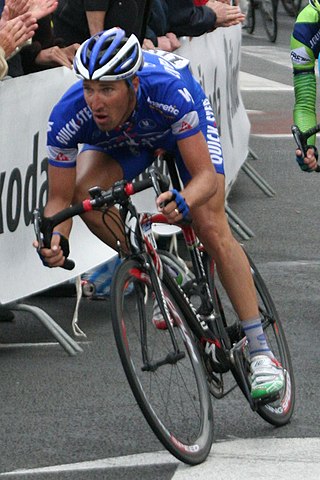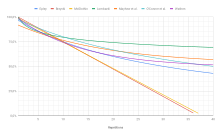
Powerlifting is a strength sport that consists of three attempts at maximal weight on three lifts: squat, bench press, and deadlift. As in the sport of Olympic weightlifting, it involves the athlete attempting a maximal weight single-lift effort of a barbell loaded with weight plates. Powerlifting evolved from a sport known as "odd lifts", which followed the same three-attempt format but used a wider variety of events, akin to strongman competition. Eventually, odd lifts became standardized to the current three.

Heart rate is the frequency of the heartbeat measured by the number of contractions of the heart per minute. The heart rate can vary according to the body's physical needs, including the need to absorb oxygen and excrete carbon dioxide, but is also modulated by numerous factors, including genetics, physical fitness, stress or psychological status, diet, drugs, hormonal status, environment, and disease/illness as well as the interaction between and among these factors. It is usually equal or close to the pulse measured at any peripheral point.
Basal metabolic rate (BMR) is the rate of energy expenditure per unit time by endothermic animals at rest. It is reported in energy units per unit time ranging from watt (joule/second) to ml O2/min or joule per hour per kg body mass J/(h·kg). Proper measurement requires a strict set of criteria to be met. These criteria include being in a physically and psychologically undisturbed state and being in a thermally neutral environment while in the post-absorptive state (i.e., not actively digesting food). In bradymetabolic animals, such as fish and reptiles, the equivalent term standard metabolic rate (SMR) applies. It follows the same criteria as BMR, but requires the documentation of the temperature at which the metabolic rate was measured. This makes BMR a variant of standard metabolic rate measurement that excludes the temperature data, a practice that has led to problems in defining "standard" rates of metabolism for many mammals.
Muscle fatigue is when muscles that were initially generating a normal amount of force, then experience a declining ability to generate force. It can be a result of vigorous exercise, but abnormal fatigue may be caused by barriers to or interference with the different stages of muscle contraction. There are two main causes of muscle fatigue: the limitations of a nerve’s ability to generate a sustained signal ; and the reduced ability of the muscle fiber to contract.

Anaerobic exercise is a type of exercise that breaks down glucose in the body without using oxygen; anaerobic means "without oxygen". In practical terms, this means that anaerobic exercise is more intense, but shorter in duration than aerobic exercise.
V̇O2 max (also maximal oxygen consumption, maximal oxygen uptake or maximal aerobic capacity) is the maximum rate of oxygen consumption attainable during physical exertion. The name is derived from three abbreviations: "V̇" for volume (the dot over the V indicates "per unit of time" in Newton's notation), "O2" for oxygen, and "max" for maximum and usually normalized per kilogram of body mass. A similar measure is V̇O2 peak (peak oxygen consumption), which is the measurable value from a session of physical exercise, be it incremental or otherwise. It could match or underestimate the actual V̇O2 max. Confusion between the values in older and popular fitness literature is common. The capacity of the lung to exchange oxygen and carbon dioxide is constrained by the rate of blood oxygen transport to active tissue.

Exercise intensity refers to how much energy is expended when exercising. Perceived intensity varies with each person. It has been found that intensity has an effect on what fuel the body uses and what kind of adaptations the body makes after exercise. Intensity is the amount of physical power that the body uses when performing an activity. For example, exercise intensity defines how hard the body has to work to walk a mile in 20 minutes.

Strength training, also known as weight training or resistance training, involves the performance of physical exercises that are designed to improve strength and endurance. It is often associated with the lifting of weights. It can also incorporate a variety of training techniques such as bodyweight exercises, isometrics, and plyometrics.

A squat is a strength exercise in which the trainee lowers their hips from a standing position and then stands back up. During the descent, the hip and knee joints flex while the ankle joint dorsiflexes; conversely the hip and knee joints extend and the ankle joint plantarflexes when standing up. Squats also help the hip muscles.

High-intensity interval training (HIIT) is a training protocol alternating short periods of intense or explosive anaerobic exercise with brief recovery periods until the point of exhaustion. HIIT involves exercises performed in repeated quick bursts at maximum or near maximal effort with periods of rest or low activity between bouts. The very high level of intensity, the interval duration, and number of bouts distinguish it from aerobic (cardiovascular) activity, because the body significantly recruits anaerobic energy systems. The method thereby relies on "the anaerobic energy releasing system almost maximally".
In weight training, training to failure is repeating an exercise to the point of momentary muscular failure, i.e. the point where the neuromuscular system can no longer produce adequate force to overcome a specific workload. Two systematic reviews published in 2021 found no benefit to training to failure on hypertrophy, while one of the reviews found some evidence that not-to-failure training is superior for strength.
Circuit training is a form of body conditioning that involves endurance training, resistance training, high-intensity aerobics, and exercises performed in a circuit, similar to high-intensity interval training. It targets strength building and muscular endurance. An exercise "circuit" is one completion of all set exercises in the program. When one circuit is completed, one begins the first exercise again for the next circuit. Traditionally, the time between exercises in circuit training is short and often with rapid movement to the next exercise.
Electrical muscle stimulation (EMS), also known as neuromuscular electrical stimulation (NMES) or electromyostimulation, is the elicitation of muscle contraction using electric impulses. EMS has received an increasing amount of attention in the last few years for many reasons: it can be utilized as a strength training tool for healthy subjects and athletes; it could be used as a rehabilitation and preventive tool for people who are partially or totally immobilized; it could be utilized as a testing tool for evaluating the neural and/or muscular function in vivo. EMS has been proven to be more beneficial before exercise and activity due to early muscle activation. Recent studies have found that electrostimulation has been proven to be ineffective during post exercise recovery and can even lead to an increase in Delayed onset muscle soreness (DOMS).

A pull-up is an upper-body strength exercise. The pull-up is a closed-chain movement where the body is suspended by the hands, gripping a bar or other implement at a distance typically wider than shoulder-width, and pulled up. As this happens, the elbows flex and the shoulders adduct and extend to bring the elbows to the torso.
Incremental exercise is physical exercise that increases in intensity over time.

The Bruce protocol is a standardized diagnostic test used in the evaluation of cardiac function and physical fitness, developed by American cardiologist Robert A. Bruce.
The interplay of exercise and music has long been discussed, crossing the disciplines of biomechanics, neurology, physiology, and sport psychology. Research and experimentation on the relation between music and exercise dates back to the early 1900s, when investigator Leonard Ayres found that cyclists pedaled faster in the presence of a band and music, as opposed to when it was silent. Since then, hundreds of studies have been conducted on both the physiological and psychological relationship between music and physical activity, with a number of clear cut relationships and trends emerging. Exercise and music involves the use of music before, during, and/or after performing a physical activity. Listening to music while exercising is done to improve aspects of exercise, such as strength output, exercise duration, and motivation. The use of music during exercise can provide physiological benefits as well as psychological benefits.
A strength and conditioning coach is a physical performance professional who uses exercise prescription to improve the performance of competitive athletes or athletic teams. This is achieved through the combination of strength training, aerobic conditioning, and other methods.

Power training typically involves exercises which apply the maximum amount of force as fast as possible; on the basis that strength + speed = power. Jumping with weights or throwing weights are two examples of power training exercises. Regular weight training exercises such as the clean and jerk and power clean may also be considered as being power training exercises due to the explosive speed required to complete the lifts. Power training may also involve contrasting exercises such as heavy lifts and plyometrics, known as complex training, in an attempt to combine the maximal lifting exertions with dynamic movements. This combination of a high strength exercise with a high speed exercise may lead to an increased ability to apply power. Power training frequently specifically utilises two physiological processes which increase in conjunction with one another during exercise. These are deep breathing, which results in increased intra-abdominal pressure; and post-activation potentation, which is the enhanced activation of the nervous system and increased muscle fibre recruitment. Power training programmes may be shaped to increase the trainee's ability to apply power in general, to meet sports specific criteria, or both.
Velocity based training (VBT) is a modern approach to strength training and power training which utilises velocity tracking technology to provide rich objective data as a means to motivate and support real-time adjustments in an athlete's training plan. Typical strength and power programming and periodisation plans rely on the manipulation of reps, sets and loads as a means to calibrate training stressors in the pursuit of specific adaptations. Since the late 1990s, innovations in bar speed monitoring technology has brought velocity based training closer to the mainstream as the range of hardware and software solutions for measuring exercise velocities have become easier to use and more affordable. Velocity based training has a wide range of use cases and applications in strength and conditioning. These include barbell sports such as powerlifting and Olympic weightlifting and Crossfit, as well as rock climbing.Velocity based training is widely adopted across professional sporting clubs, with the data supporting many periodisation decisions for coaches in the weight room and on the field.

























